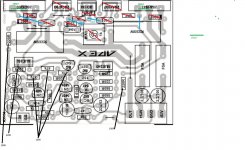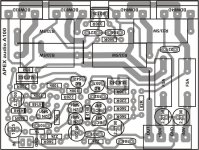GSD is for a Lateral mosFET.
You cannot swap in a BJT for a Lateral.
Vertical mosFETs are GDS and physically can be changed to BJT, but the amplifier will almost certainly require re-designing to make it work with the BJTs.
You cannot swap in a BJT for a Lateral.
Vertical mosFETs are GDS and physically can be changed to BJT, but the amplifier will almost certainly require re-designing to make it work with the BJTs.
Nice work, if you want use 2SC5200/2SA1943 go to AX10.This amp is super easy to build - went together faster than any amp I have built. I am still waiting for the output stages but have some 2SC5200/2SCA1943's slipped in their place to get a feel how big this amp is. It is small! Smaller than a typical TPA311x class D amp.
I am a bit impatient waiting for the MOSFETs to get here...
Is there anyway this amp can work with BJT's rather than MOSFETs? What would happen if I powered this up with the PNP on left and NPN on right.
The MOSFETs are G - S - D and the BJTs are B - C - E.
Would it be PNP on left and NPN on right given Vcc(+) is on left and negative is on right side.
Apex i use PCB from AX14 to A100
2SD2389/2SB1559
And have DC in out... (43V DC)
If fast on-off trafo there is sound distorted ~ 2 second and quiet
0.33R - 1mV
Connected like that...
2SD2389/2SB1559
And have DC in out... (43V DC)
If fast on-off trafo there is sound distorted ~ 2 second and quiet
0.33R - 1mV
Connected like that...
Attachments
Last edited:
Zinyx
Please make sure that SG is connected to the main star GND point in PSU. For a quick test You can connect SG to the GND on the amplifier board.
Please make sure that SG is connected to the main star GND point in PSU. For a quick test You can connect SG to the GND on the amplifier board.
DC problem gone i put 32R about 320R to MJE350 😉
Work good, I got the bass 🙂
0.33R - 0.8mV DC
Out - 3mv DC, 65mV AC
It's OK ??
Work good, I got the bass 🙂
0.33R - 0.8mV DC
Out - 3mv DC, 65mV AC
It's OK ??
Apex A100 (AX14 PCB) 2SD2389/2SB1559 +/- 47V DC
https://youtu.be/ESBmzfoLV3s
I buy coil for MDS08 and think A100 should be enough for me...
Thanx Apex
https://youtu.be/ESBmzfoLV3s
I buy coil for MDS08 and think A100 should be enough for me...
Thanx Apex

Hello Apex and friends,
This query is regarding the Apex FX8 schematic. I was wondering if a capacitor is required across the output stage biasing diode (1N4007) ? What is the function of such a capacitor and how do we compute it's value?
What's the final approach for the output stage biasing? Can I use just the diode, or should I consider a variable resistor (1K) ?
Thanks
This query is regarding the Apex FX8 schematic. I was wondering if a capacitor is required across the output stage biasing diode (1N4007) ? What is the function of such a capacitor and how do we compute it's value?
What's the final approach for the output stage biasing? Can I use just the diode, or should I consider a variable resistor (1K) ?
Thanks
Apex A100 (AX14 PCB) 2SD2389/2SB1559 +/- 47V DC
https://youtu.be/ESBmzfoLV3s
I buy coil for MDS08 and think A100 should be enough for me...
Thanx Apex
Nice work.
Regards
I figured it was not so easy... 🙁
While waiting, why not (thermally) couple the LTP transistor pair? If the legs are already too small you can use copper plate in between the transistors.
While waiting, why not (thermally) couple the LTP transistor pair? If the legs are already too small you can use copper plate in between the transistors.
Would that help improve the balance stability? I am surprised they don't make dedicated LTP transistors with two on same die with 6 legs - I suppose 8 leg dip like an op amp package would work.
The two VAS(?) transistors BD139 and BD140 also show a metal plate should be attached to them but I wonder if that's for heat sinking rather than thermal coupling.
Would that help improve the balance stability? I am surprised they don't make dedicated LTP transistors with two on same die with 6 legs - I suppose 8 leg dip like an op amp package would work.
I think thermal coupling the LTP is more effective than using degeneration resistors.
In the past there are a lot of such matched transistors in one package (5-leg or 8 and 14-pin IC). I'm still using such transistors. Currently my FX8 is still using 2SC2240-BL, later will be compared with the 5-leg dual transistor which seems to be better on paper.
The two VAS(?) transistors BD139 and BD140 also show a metal plate should be attached to them but I wonder if that's for heat sinking rather than thermal coupling.
The original design was using smaller transistors for the VAS (BC639/640).
Jay,
How do you like your FX8? I want to do a comparison thread where I keep the speaker fixed and swap out various amps and make sound clips.
How do you like your FX8? I want to do a comparison thread where I keep the speaker fixed and swap out various amps and make sound clips.
Jay,
How do you like your FX8?
Still struggling with power supply sound... 😀 I have a different way to assess amplifiers...
I want to do a comparison thread where I keep the speaker fixed and swap out various amps and make sound clips.
It is hard when the power supply has to be different... A power supply can kill the sound of an amplifier... (but only microscopic to most ears)
I'm very very curious to see how the amplifiers will sound like when recorded into a clip...
Jay,
I know you have very sensitive golden ears but what I am talking about are very obvious audible differences going from class D to class AB (various flavors) to quasi class A (like Circlophone), to true class A (like Pass ACA or JLH). It may be possible to stick with same 35v dual rail supply from toroidal transformer followed by basic PSU circuit like the one Destroyer X designed for the Dx. To get the very low micro-ripple PSU will take an active transistor controlled linear circuit. Maybe I need to build one of those next. I can put a variable regulator to dial voltage to what is needed.
I hear very obvious differences in LM3886 vs Dx (and hopefully can add FX8 when I have it completed) vs Circlophone vs class D (IRS2092) and class D (TPA311x).
I know you have very sensitive golden ears but what I am talking about are very obvious audible differences going from class D to class AB (various flavors) to quasi class A (like Circlophone), to true class A (like Pass ACA or JLH). It may be possible to stick with same 35v dual rail supply from toroidal transformer followed by basic PSU circuit like the one Destroyer X designed for the Dx. To get the very low micro-ripple PSU will take an active transistor controlled linear circuit. Maybe I need to build one of those next. I can put a variable regulator to dial voltage to what is needed.
I hear very obvious differences in LM3886 vs Dx (and hopefully can add FX8 when I have it completed) vs Circlophone vs class D (IRS2092) and class D (TPA311x).
what I am talking about are very obvious audible differences going from class D to class AB (various flavors) to quasi class A (like Circlophone), to true class A (like Pass ACA or JLH).
Let's see if I can detect HF issues in the coming blind test. Better if you can include/reveal the distortion spectrum. Class-D has obviously HF issue. Class-B tends to have high order distortion (which I considered as HF issue).
It may be possible to stick with same 35v dual rail supply from toroidal transformer followed by basic PSU circuit like the one Destroyer X designed for the Dx. To get the very low micro-ripple PSU will take an active transistor controlled linear circuit.
It is the issue with interference that I'm worry about. With the same power supply then it is fair for all amps.
I hear very obvious differences in LM3886 vs Dx (and hopefully can add FX8 when I have it completed) vs Circlophone vs class D (IRS2092) and class D (TPA311x).
Your assessment was correct regarding 3886 and DX. But FX8 is IMO a much better amp...
Class-A like ACA will highly dependent on the speaker used. It will be an outlier...
Great - looking forward to my FX8 then. It's amazing how small and compact it can be and still sound great. Which lateral Mosfet are you using for the output? I know you said certain parts are hard to come by where you are.
Great - looking forward to my FX8 then. It's amazing how small and compact it can be and still sound great. Which lateral Mosfet are you using for the output? I know you said certain parts are hard to come by where you are.
Small and compact is actually a good recipe... I'm temporarily using Hitachi K2221/J352.
I'm just reading a thread where a fella found First watt's F6 sounded horrible and praised an LM3886 much higher than I think it deserved. What I'm saying is, people have different way/taste when judging an amp, so you cannot trust my taste (for example, I don't like DX amp like you do and many others) 😀
Is the Dx not favorable for you because of higher order harmonics?
A LM3886 will have more power than a F6 I think and some people need the power because of inefficient speakers.
So it's important to have a fairly sensitive speaker for the comparison. At least 90db I think.
A LM3886 will have more power than a F6 I think and some people need the power because of inefficient speakers.
So it's important to have a fairly sensitive speaker for the comparison. At least 90db I think.
- Home
- Amplifiers
- Solid State
- 100W Ultimate Fidelity Amplifier

